Does live sonar technology help casual anglers catch more crappie in Kansas?
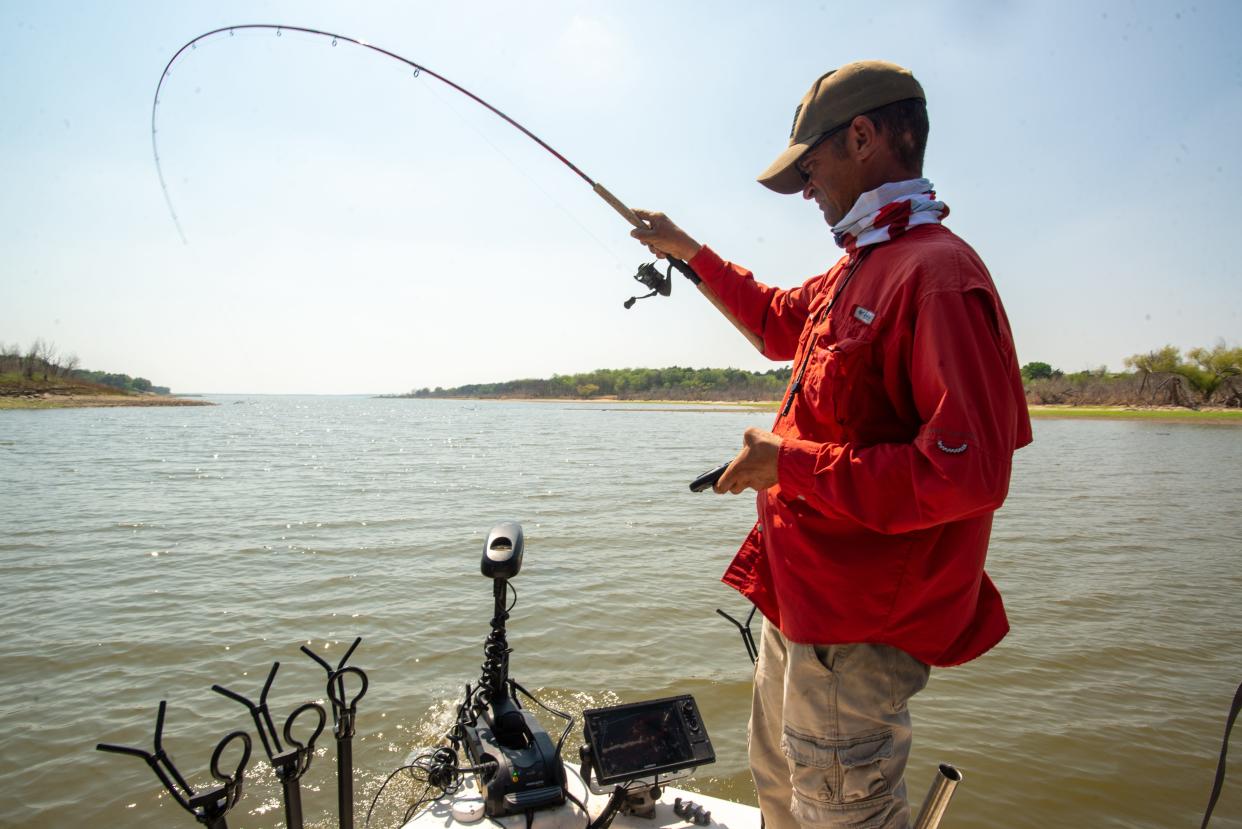
The state of Kansas recently went fishing for answers as to whether a relatively new sonar technology enables casual anglers to catch crappie more easily.
The groundbreaking experiment in late 2021 focused on the use of live imaging sonar technology.
"The data collected demonstrated that while LIS may improve angler catch and size of crappie by casual weekend anglers, overall differences were statistically minimal," the Kansas Department of Wildlife and Parks said.
Perhaps more importantly, the data suggested that the live sonar poses an "overall low risk of long-term damage to crappie populations," KDWP said.
Still, not everyone's hooked on the results.
Joe Bragg, founder of the Kansas Crappie Club, told The Capital-Journal he thinks the study's conclusions are "nonsense."
More: Kansas sees increasing numbers of mountain lions, black bears and elk
Live sonar leading to larger fish caught during competition
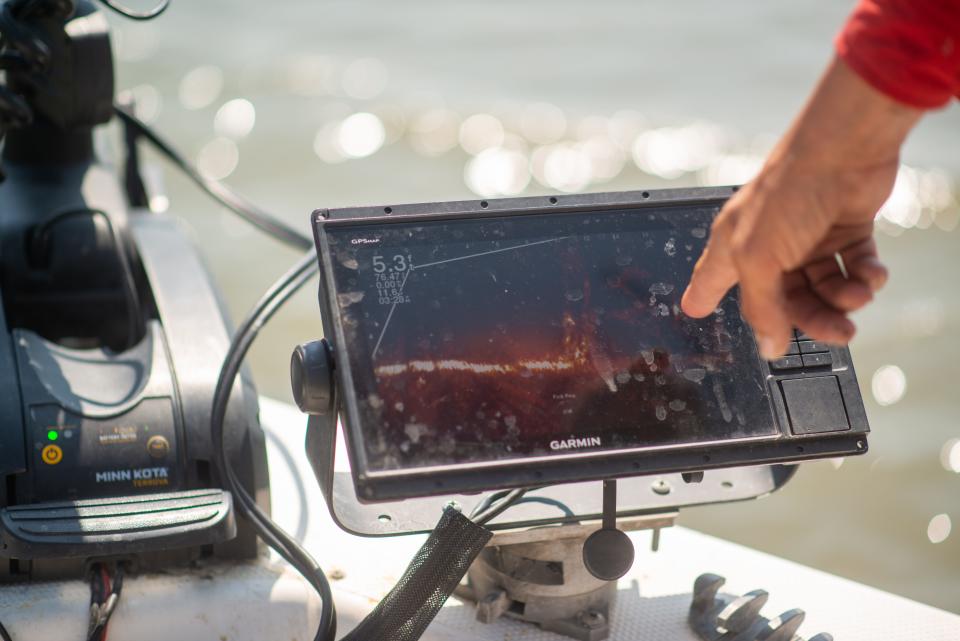
Bragg is a Florida native who chose to stay in Kansas after serving with the Army at Fort Riley, then being discharged in 2013.
He has been a full-time fishing guide for about seven years and is based at Geary County's Milford Lake.
Bragg in 2015 founded the Kansas Crappie Club, which has 11,800 members on its Facebook site. Kansas is home to two types of crappie: black crappie and white crappie.
The Crappie Club has existed during a time period that has brought significant improvement to the sonar fishing technology that was already in place, Bragg said.
He said the live sonar improvements are responsible for the progressively larger average fish size the Crappie Club has seen at its tournaments in recent years.
Though various companies offer that technology, it's commonly known as "LiveScope," the same name of one of the most popular systems, Garmin's Panoptix LiveScope, which was introduced to the market in 2018, Bragg said.
LiveScope systems provide a vastly improved picture of what's underwater compared to what was previously available, he said, adding that they generally cost between about $2,000 and $5,000.
LiveScopes have made fishing more like hunting, Bragg said. They won't make the fish bite, but they enable anglers to see where they are.
Once Bragg finds a big fish, he said, he'll follow it until either he catches it or it manages to get out of his sight, which rarely happens.
"I've chased fish hundreds of yards," he said.
More: Security camera video shows mountain lion roaming through neighborhood in Wichita
Live sonar 'not fair to the fish'

While LiveScope has enhanced Bragg's ability to catch fish, he has mixed feelings about it.
Bragg likes the way LiveScope attracts youngsters to the sport.
Live sonar makes fishing kind of like playing a video game, Bragg said.
"When it comes to getting kids interested in fishing, it's the best thing that's ever happened," he said.
"But the fishing guide side of me hates it," Bragg added. "It wishes they’d take it and throw it in the trash can."
LiveScope is "not fair to the fish" and takes much of the sport out of fishing, he said.
"Now the average guy can just show up and drop a jig on the face of a trophy fish," Bragg said.
LiveScope also makes fishing less fun, he said.
"You just stand here and stare at a screen," Bragg said. "It's kind of gotten boring."
More: Watch this shocked college student capture a black bear on camera in Baxter Springs
Expert uses live sonar to catch crappie in first 5 minutes
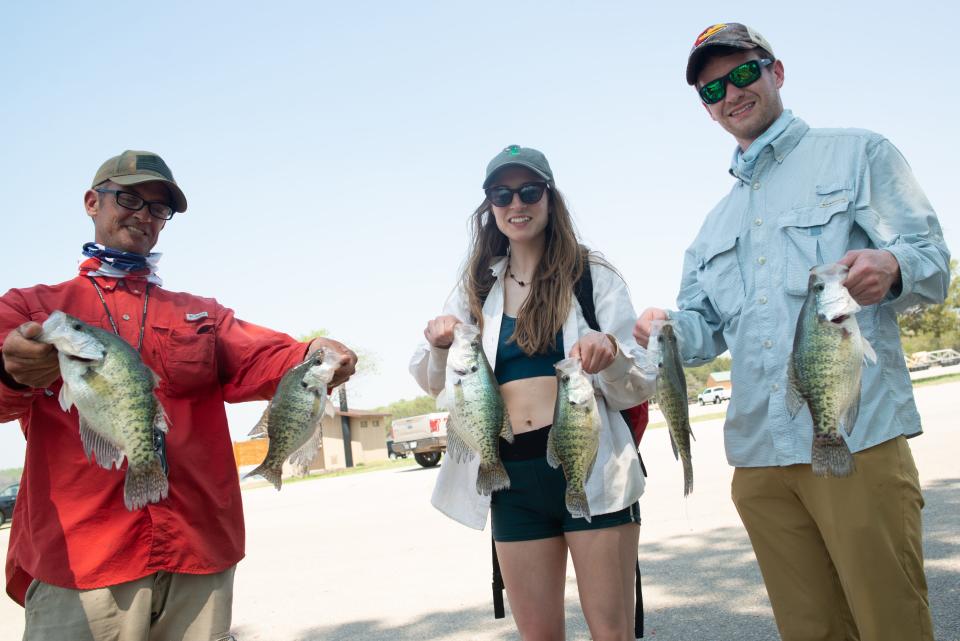
Conditions were windy and temperatures in the mid-90s Tuesday as Bragg demonstrated the use of his Garmin LiveScope to a Capital-Journal reporter and photographer at Milford Lake.
Bragg's 24 1/2-foot-long bay boat carried stationary and portable LiveScope screens, which displayed colorful, high-resolution images showing what was below the water.
Bragg maneuvered his boat into an area in a cove where the water was about five feet deep. He pointed out ball-like images on one of his screens, which he said were crappie.
Bragg walked to the front of the boat carrying a fishing rod in his right hand and the portable LiveScope screen in his left.
He began fishing, peering at the images on the screen while looking for a big crappie.
Before long, he cast his jig into the water above one of the ball-like figures.
Bragg's jig could be seen on the screen descending through the water toward the fish.
"You set that jig right on their nose, and they'll eat it," he said.
The fish swallowed the jig. Bragg then reeled it into the boat.
The fish was a female crappie, which was pregnant and spawning. Bragg estimated she weighed one and a half pounds, which he described as being "decent-sized."
Bragg stressed that live sonar technology had enabled him to catch such a crappie only five minutes after he began fishing.
He tossed the fish back into the water.
"Go make some babies," he said.
More: 10-year-old Kansas girl shoots 26-point whitetail deer from 200 yards away
Why did Kansas officials create a live sonar study?
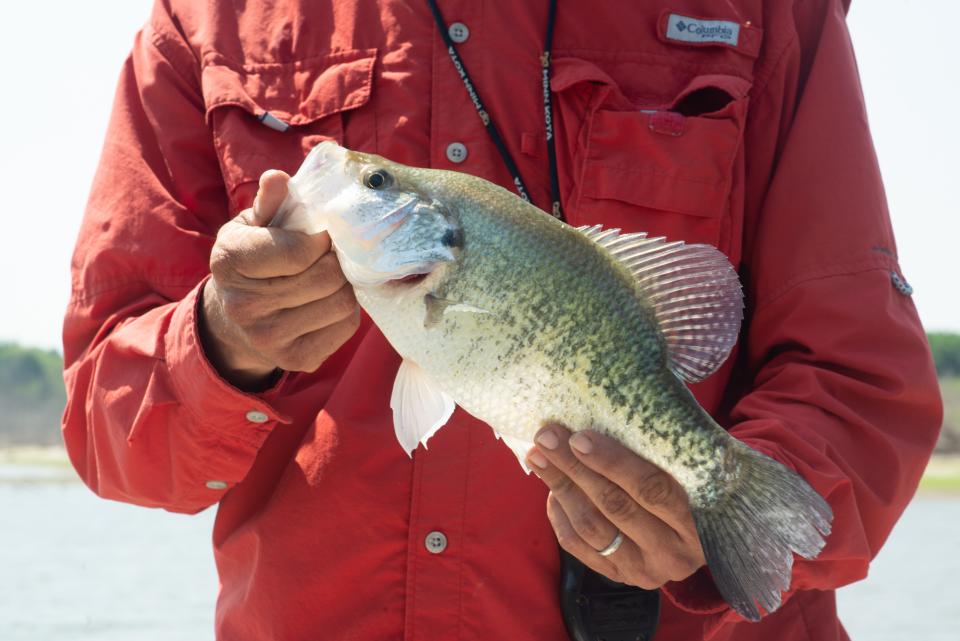
The ease with which live sonar helps anglers catch crappie prompted Bragg to be among those who voiced concern in late 2020 to KDWP that the practice might bring about an overharvest of the state's crappie population.
Kansas anglers caught a great deal of crappie in 2020, said Ben Neely, who coordinated last December's live sonar study in his job as a fisheries research biologist for KDWP.
Though the state doesn't have hard data to back that up, Neely told The Capital-Journal: "Our biologists have a pretty good finger on the pulse of the fisheries they manage. If fishing is good, or bad, they hear about it."
A perfect storm of circumstances apparently triggered 2020's abundant fish catch.
First, 2019 had brought Kansas flooding that Sen. Jerry Moran described as being "widespread and severe."
That was bad for people but good for fish. Record high water levels at the state's reservoirs created "a lot of great new fish habitat," Neely said.
The higher waters also hampered angler access at state reservoirs, enabling a number of fish to survive another year rather than ending up in a frying pan.
Then, in March 2020, COVID-19 hit. People were looking for ways to have fun without getting infected, and many chose fishing, Neely said.
The state sold 36% more fishing licenses in 2020 than it did in 2019, he said.
Bragg said because many anglers in 2020 had been laid off or furloughed, they had more free time and were consequently able to spend more time fishing than in the past.
The year 2020 also brought a noticeable increase in the number of Kansas anglers using live sonar technology, Bragg said.
Many anglers who'd previously considered themselves unable to afford such technology received unexpected windfalls that year, in the form of federal stimulus checks, which enabled them to afford to buy a live sonar system, he said.
Did live sonar study show risk of crappie overharvesting?
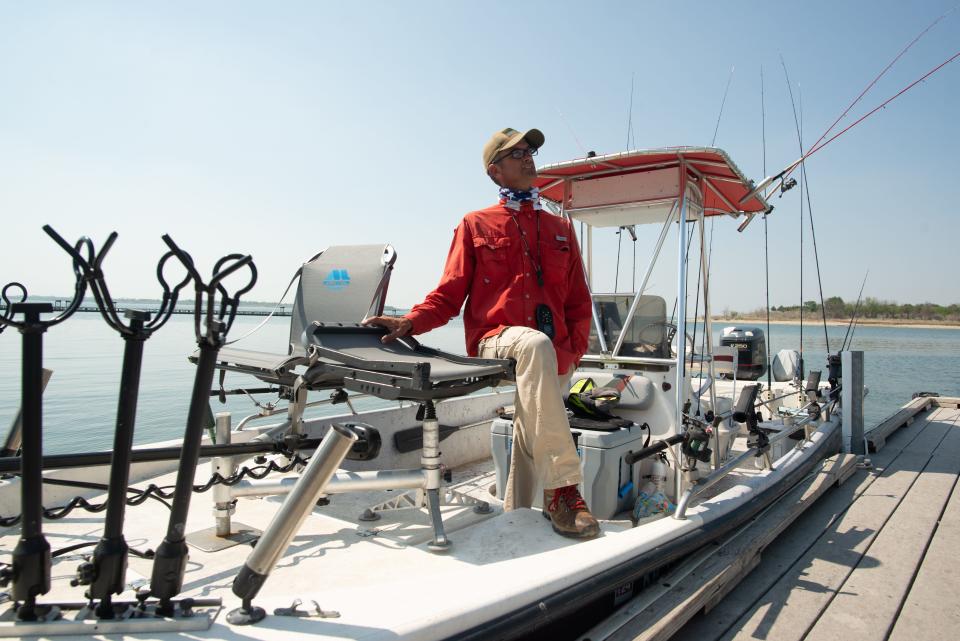
The Kansas Fish and Game Commission responded to the state's high 2020 crappie catch by asking the KDWP's fisheries division to look into whether live sonar posed a risk of long-term overharvest of the state's crappie population, Neely said.
Fisheries staff members looked for past research on the topic and found three states that had carried out limited surveys regarding live sonar, Neely said.
But the technology was just new enough that no one had done a full-blown study, he said.
So KDWP's fisheries and wildlife divisions teamed up with the biology department at Manhattan's Kansas State University to carry out a groundbreaking experiment at Cedar Bluff Reservoir, a roughly 500-acre lake south of WaKeeney.
Thirty-two anglers took part, including 31 men and one woman. Most were KDWP employees, while some were volunteers and/or friends of the agency.
Participants were separated into 16 two-person teams, with the fishing taking place in late November and early December.
Though various brands of live sonar are available on the market, KDWP opted to use Garmin.
"We were trying to use what the anglers told us they were using," Neely said.
Conducting the study cost a total of roughly $10,000, including salaries, equipment, lodging and costs to purchase four LiveScope systems, Neely said. Some participants used other LiveScope systems, which KDWP already had on hand.
KDWP was careful to keep the experiment's conditions balanced.
Each team fished for seven hours on two different days, once with Garmin LiveScope and once without it, over a period of two weeks.
Each team fished on the north side of the lake one day and on the south side the other.
Sonar was used by eight teams on the north side, and eight teams on the south.
All the fish the participants caught were measured, then returned to the water., Neely said.
The anglers were told to fish as if they were competing in a tournament where the winner would be whoever recorded "the greatest length of all crappie caught," he said.
That would ensure that if anyone was catching numerous fish of some other type, they would have an incentive to go elsewhere to try to catch the desired species, crappie.
Weather conditions remained "decent" throughout the time period involved, Neely said.
The biggest concern had been that wind would make conditions unsafe or unfishable, but that didn't happen, he said.
"We were very happy with the environmental stability," Neely said.
More: Kansas-shot buck has the second-largest antler size of any hunter-taken deer on record
Kansas officials say live sonar study results were unexpected
KDWP announced the study's findings in a Feb. 17 news release.
Many anglers had been taking sides regarding the introduction, and proliferation, of live imaging sonar that "allows anglers to view fish and structure, below and around their vessel, in real time and with great clarity," the release said.
"While some believe LIS adds immense value to the overall fishing experience, others believe it poses an ethical dilemma, blurring the lines of 'fair chase,'" the release said. "So, when is an advancement too advanced? That’s the data KDWP Fisheries staff sought but couldn’t find; so, they developed it themselves in a first-of-its-kind study."
The release described the results of that study as being "unexpected."
Participating teams that used Garmin LiveScope averaged a catch of 7.3 crappie per day while those who didn't averaged 6.3 crappie per day, the release said.
When other species of fish were counted, teams using Garmin LiveScope caught 14.4 fish per day while those who didn't averaged 12.9 fish per day.
Anglers using Garmin LiveScope caught slightly larger crappie, averaging 10.8 inches, compared to an average of 10.5 inches caught by anglers not using that technology.
Nine of the teams caught more crappie with live sonar while seven teams caught more crappie without it, the release noted.
KDWP wasn't able to provide The Capital-Journal a copy of the study document.
Neely said it will be made public after a peer review process is finished.
The news release quoted KDWP Secretary Brad Loveless as saying the study was "a fine example of how our staff continue to operate off of the best-available data to make science-based decisions that benefit not only the resource, but our users."
Loveless added, "I’m confident this study will be just one of many that the conservation industry looks to, as our talented staff in Kansas continue to pave the way in fisheries research and management."
How did anglers react to live sonar study?
Reactions from the fishing community were "all over the board," Neely said.
The survey's results "kind of corroborated" the findings of other states that had taken informal surveys, he said.
Still, many of the constituents KDWP serves were surprised to learn that the study indicated live sonar doesn't give a big advantage to casual anglers, Neely said.
Those surprised constituents included Bragg.
"They should have never opened that can of worms if they weren't going to do it the right way," he told The Capital-Journal.
KDWP left out one important variable — expert fishermen, Bragg said.
"They should have had some guys who really knew how to use a LiveScope," he said.
Far more fish would have been caught using live sonar if the experiment had involved anglers who had a lot of experience with it and were good at it, Bragg said.
He acknowledged live sonar probably wouldn't much benefit casual anglers "because these guys are still learning these systems."
But even the state's casual anglers tend to be "learning quick" about live sonar, Bragg said.
"Once they understand what they're looking at, it's not very hard," he said.
Bragg said he thinks the use of live sonar and the skills of those using it are expanding to the point where live sonar will eventually "make a dent" in the crappie population.
"It's going to be something they're going to have to deal with — if not now, at least in a few years, once everybody gets up to speed on it," he said. "Before, you had 15 or 20 guys in the state who were real masters at this kind of tournament fishing. But once the whole state is as good as the top guys, there's going to be a reckoning."
More: Poacher sought after Kansas trail camera sees him use artificial light to kill young buck
Study was geared toward average weekend anglers
Neely stressed that the study sought simply to gauge live sonar effects on the fishing productivity of "average weekend anglers. Two buddies on a fishing trip to a new lake who are familiar with this live imaging technology but don't necessarily know it well."
About 80% of the state's angler's fit into the "average" category while about 10% "aren't very experienced or skilled or had a bad day' and about 10% "are going to catch fish no matter what," Neely told the Kansas Fish and Game Commission Jan. 13.
"The 80% in the middle are what we dialed in on," he said.
"Future studies are being discussed that can leverage the abilities of more LIS-experienced anglers to further inform future management of crappie in Kansas," KDWP said in its Feb. 17 news release.
More: 'It's looking like a pretty warm summer': Here's what experts say as Topeka hits mid-90s
Kansas officials will keep sonar on their radar
Neely said KDWP officials appreciate all the feedback they've received about the study and are glad to see so many people care about what the agency is doing.
The study's release has spurred "a lot of conversation" about the use of live sonar for fishing in Kansas, he said.
The conversations currently taking place will help KDWP fine-tune the questions it asks as it conducts future studies, Neely added.
The agency is looking at conducting a similar type of study this coming summer involving blue catfish, he said.
Bragg said he feels glad the KDWP has sonar "on its radar."
He said he feels confident KDWP will take some sort of corrective action if it sees a drastic drop in the number of available crappie.
"I think they messed up on this study," he said. "But I trust them."
Tim Hrenchir can be reached at threnchir@gannett.com or 785-213-5934.
This article originally appeared on Topeka Capital-Journal: Live sonar could take the sport out of fishing in Kansas, anglers say

